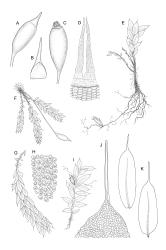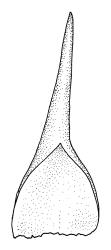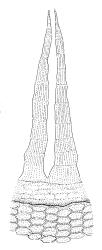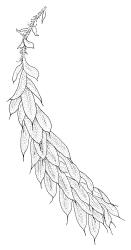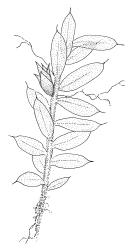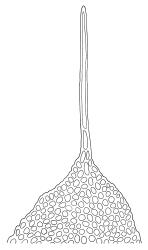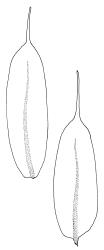- = Hymenodon helvolus Müll.Hal., Hedwigia 36: 332 (1897)
Plants small, glaucous when fresh and dry, forming epiphytic tufts. Stems erect, branched at base to form tufts, pale green, c. 7–10(–15) mm long, in cross-section with c. 1–3 layers of thick-walled cells surrounding a parenchymatous cortex and a weak central strand, beset at base with red-brown, papillose rhizoids. Leaves evenly arranged around the stem or ± complanate, erect-spreading, symmetric, broadly elliptic with an obtuse apex and a long, slender hair-point, neither concave nor decurrent, unbordered, crenulate throughout, 0.65–0.9 × 0.25–0.3 mm (excluding hair-points), becoming smaller and scale-like towards the stem base; upper laminal cells firm‑walled, mostly oblong, quadrate, or oblate, 7–9 µm in greater dimension, weakly mammillose, with an obscurely wrinkled cuticle, becoming slightly larger towards the insertion; alar cells and marginal cells not differentiated. Hair-point c. 0.25–0.50 mm and ⅓–½ the length of the lamina, composed of a single thick-walled cell for more than ¾ its length. Costa c. 30 µm wide near base, ending 75–100 µm below the hair-point base, in cross-section ± plano-convex, with 2 guide cells and an abaxial stereid group.
Rhizautoicous. Perichaetia at base of stem, red-brown, perichaetial leaves ovate-lanceolate, costate, not bordered, to c. 0.9 mm. Perigonia nidulant amongst basal rhizoids or rarely among leaf axils, brown and bud-like, with bracts c. 0.5 mm, ecostate, acute from an ovate, concave base, with c. 8 antheridia and with or without filiform paraphyses. Setae c. 9 mm, straight, smooth, c. 70–90 µm diam., scarcely twisted, yellow-brown; capsules erect, ellipsoid, c. 1.4 mm, smooth, pale red- or yellow-brown; exothecial cells rounded-quadrate, firm-walled, smooth; annulus apparently weakly differentiated (not seen clearly). Operculum obliquely rostrate from a conic base, c. 0.6 mm long. Peristome single, exostomal; exostome inserted at the capsule mouth, yellowish-brown, arising from a very low membrane, the teeth c. 350 µm long, strongly striate throughout; endostome lacking. Calyptra cucullate, 1.5 mm long. Spores spherical, 12–14.5 µm, yellow, smooth.
Wilson 1854, pl. 92, fig. 3; Scott & Stone 1976, pl. 59; Malcolm & Malcolm 2003, p. 34; Meagher & Fuhrer 2003, p. 111; Tessler 2012, fig. 10, A–G; Seppelt et al. 2019, pl. 69.
The obscure wrinkling of the cuticle is most easily observed by placing dry material under the compound microscope. The well-developed leaves in all Australasian material have costae ending well below the base of the hair-point; in a few specimens the basal leaves have longer-than-typical costae. Sainsbury’s (1955, p. 294) statement that the costa is occasionally "excurrent and filling the hair-point" has not been confirmed.
The species most frequently confused with H. pilifer are Leptostomum inclinans and Calomnion complanatum. Its smaller stature, smaller leaves and plane leaf margins are sufficient to distinguish H. pilifer from the former, while the presence of a hair-point and a peristome, lack of dimorphic leaves, and lack of dendroid rhizoidal filaments easily differentiate H. pilifer from the latter.
K; NI: N Auckland, including offshore islands (TK, LB, GB, RT), S Auckland (including Mayor I.), Gisborne (Lake Waikaremoana), Hawke’s Bay (Waiatai Valley, Mōrere Reserve), Taranaki, Wellington; SI: Nelson, Marlborough, Westland, Otago, Southland (Longwood Range, Fiordland National Park); St; Ch; A.
Australasian. Tasmania*, mainland Australia*.
On trunks of tree-ferns (especially Cyathea medullaris, C. smithii, and C. milnei) and nīkau (Rhopalostylis sapida); less commonly on other ferns (e.g., Loxogramme dictyopteris) or tree species (e.g., Leptospermum scoparium) and sometimes also occurring on rock and thin soil. Beever (1984) found that H. pilifer in a N Auckland rainforest was most frequent on C. medullaris and Rhopalostylis sapida, very rare on Dicksonia squarrosa, and absent from C. dealbata. On the South I. H. pilifer is largely confined to areas west of the Main Divide and is common on the east coast only from Dunedin southwards. It is not recorded from Canterbury L.D. and is primarily distributed at low elevations. On the North I. ranging from near sea level (c. 15 m on Little Barrier I.) to at least 850 m (Ōhakune Track, Wellington L.D.); on the South I. ranging from sea level (numerous localities) to at least 610 m (Anatoki River, Nelson L.D.). Frequently associated species include Catharomnion ciliatum and Calomnion complanatum.




